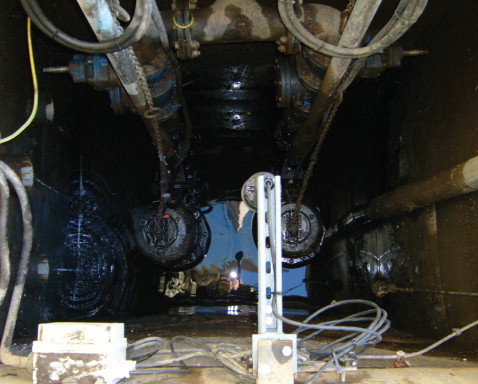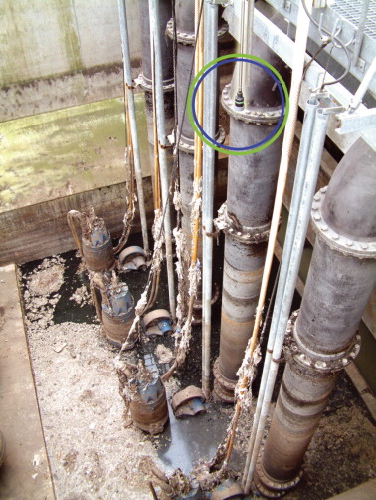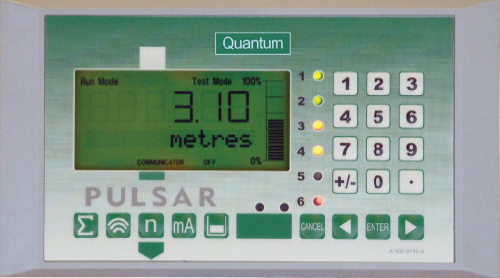


In order to reach any wastewater treatment works, sewage travels through an extensive network of collection points. These are large pits in the ground where domestic sewage is aggregated with rainwater runoff and permitted effluents before being pumped on to the next station or to the works. There are thousands of such pumping stations (‘wet wells') dotted around the land, in all types of location, from rural areas to seaside promenades, but they are most densely packed into high population areas. Each wet well typically contains two submersible pumps, controlled according to the level of sewage in it.
At one time, control simply comprised a float switch for each pump, typically set at different depths so that a rudimentary pump and assist system was used. Predictably, this was a high maintenance approach, because engineers regularly had to remove what is euphemistically called ‘ragging' from the equipment. One of the most costly problems facing water companies is that of ragging, which is the fouling of pump impellers, a long-standing nuisance that eats up thousands of hours of maintenance time in sewage pumping stations.
A non-contacting measurement and control method was required and, since the late 1980s, the preferred technique for measuring the level has been the non-contacting ultrasonic type.
Ultrasonic measuring
A typical ultrasonic measuring system consists of a transducer ‘head' positioned directly above the open top of the well, plus a separate control unit, which handles signal processing, communication and control. An ultrasonic pulse (around 50kHz) is fired at the liquid surface and the time taken for the echo to return to the transducer head is measured and converted into a distance. The technology was given a huge boost in acceptance by the maturing of digital signal processing techniques. This made such measurements reliable and not prone to the effects of other echoes that often resulted from the proximity of ladder rungs, chains and pump heads etc. Such echoes compete with the true echo required from the surface of the contained sewage.
The early units did little more than measure level, and pump control was undertaken by PLCs programmed individually for particular applications. As the technology has progressed, so the range of functions that can be taken on by the ultrasonic controller has also developed. The control emphasis has shifted away from the PLC towards the self-contained device. This makes perfect sense, as the level controller has to be there anyway and, as it is a dedicated standard unit, it can contain all the control functions required and be configured either on site or prior to installation.
Users have driven the development of control functions within a modern ultrasonic device. Manufacturers have responded to users' demands by building devices that meet their changing needs. There is a bewildering range of different pump control options built into an ultrasonic system as standard – duty/assist, duty/standby, alternating duty pump, first on/first off and measuring pump run hours etc. However, considering all the possible configurations of a two- or three-pump set, the control system has to work with any arrangement that the engineer needs. Most ultrasonic controllers offer at least a 4-20mA output proportional to the (liquid) level, plus a number of control relays to switch the pumps on and off. Alarms can be provided to warn of the level going out of band, or if the rate of change of level exceeds a certain value – which could indicate a failing pump that needs maintenance. Increasingly, RS485 communications, such as Profibus, are seen as essential tools for configuration of the device and for monitoring.
New parameters
In recent years, certain specialist applications have developed and new parameters are being monitored. One example is the increasing need to measure the volume of liquid pumped from each station. Each treatment works is at the heart of a network, with a catchment area of land to drain. If the volume pumped from each station is known, then control and management is made simpler. Of course, a flowmeter can be installed, but why do that when you have a measurement device in place already? The ultrasonic controller measures the level, and derives volume pumped from a measurement of the cross-sectional area of the well. In the same way, pump efficiency can also be recorded and monitored; some systems will compare pumped volume with theoretical pump efficiency and report (via Profibus or other digital communications protocol) how the pumps are performing, making it easier to determine a maintenance schedule.
So, we have seen how the modern ultrasonic control unit has provided measurement sophistication. Let us now look at other ways in which water engineers are increasingly using the technology to save both time and money, and simultaneously reduce carbon footprints.
With the latest generation of controllers, such as Pulsar's Zenith and Quantum devices, there are further possibilities, as the addition of digital inputs and outputs allows the unit to warn of pump failure. Controllers can also accept signals from ancillary pieces of equipment such as rain gauges.
Saving energy
Energy cost is a key issue. Prices vary during the course of the day, with extra complication during the winter because of the implementation of TRIAD periods. These are, in effect, fines imposed by electricity suppliers to encourage industrial energy users to try to avoid electricity usage as far as possible during high tariff periods. To give an indication of the way in which these periods work, a TRIAD will occur typically three times during the winter for approximately an hour each time, during which the price of electricity rises from the November peak of around 6p/kWhr to an astonishing £10/kWhr. If enough notice is provided, then high demand equipment can be switched off for the duration of the TRIAD, but the very high numbers of pumping stations means that this is not really practical.
Higher specification control units include sophisticated software routines. An example is Pulsar's Peak Tariff Avoidance (PTA) routine that deals with these high energy cost periods. The sequence operates as follows:
The wet well needs to be as empty as possible before the High Tariff Period (HTP) begins, and as full as possible when it ends. The control unit will therefore pump down as far as possible (a safe limit below the normal low level of the station) before the HTP begins. It will then monitor the rate of fill of the wet well, calculating the time it will take to fill to a maximum safe level, which may be considerably higher than the normal high level of the well. The pumps will only be used when they are required to drop the level below an overflow condition. Under lower tariff conditions, the pumps would then run until the low level was reached, but the PTA routine will allow pumps to run only until a level is reached where they may be switched off. This will allow the well to come back to its maximum safe level at the end of the HTP, so pumping is kept to an absolute minimum throughout it.
Unusual events
In some situations, it may be necessary to take into consideration extraordinary factors such as sudden storm surges. Here, a rain gauge signal can be brought in, allowing the controller to take into consideration the likelihood of an increase in incoming flow rate and pump the level down accordingly, protecting the station from swamping.
Quantum can also be programmed to provide an alarm based on the time remaining before the station spills over. This is vital for water companies, which face risk of prosecution if a station pollutes the local environment. The likelihood of a ‘spill' depends both on the rate of change of the level and the operating efficiency of the pumps, which can be affected by failure, blockage or under-performance. If a pump has failed, the rate of change may not be important; the overspill more so, because the level may well creep up slowly to reach a danger point. More important is to know how much time remains before a critical high level (the overspill point), is reached. Quantum takes all the inflow and outflow rates of the station together and calculates the time remaining before a spill, providing a warning in plenty of time for the site operators to take remedial action.
Perhaps one of the key issues facing water engineers is that of efficient use of manpower. If a pump trips out, a technician has to visit the site, often simply to press a button and restart the pump. This can lead to a lot of wasted time and effort, not to mention the carbon footprint implications of such journeys. Quantum is an example of the latest generation of pump station controller, and it includes ten relays (digital outputs) and seven digital inputs. The digital inputs are used to detect the status of the pumps, and some of the digital outputs are dedicated to the pumps' trip circuit. The digital outputs restart tripped pumps automatically – a major saving in time for the maintenance staff. If the pump cannot be restarted after half an hour, or if the pump trips six times within a twenty-four hour period, then an alarm will warn site management of a possible problem.
Anyone who has not looked at what the latest generation of ultrasonic controllers has to offer will, I am sure, be surprised by how sophisticated the technology has become. It is probably worth mentioning too, that all of this capability is available at under £1000 / control system, which compares very favourably with a bespoke programmed PLC system.
Contact Keith Flint Sales and marketing director Pulsar Process Measurement Sandy's Road Malvern Worcestershire WR14 1JJ UK Tel: +44 (0) 1684 891371 Fax: +44 (0)1684 575985, Web: www.pulsar-pm.com






